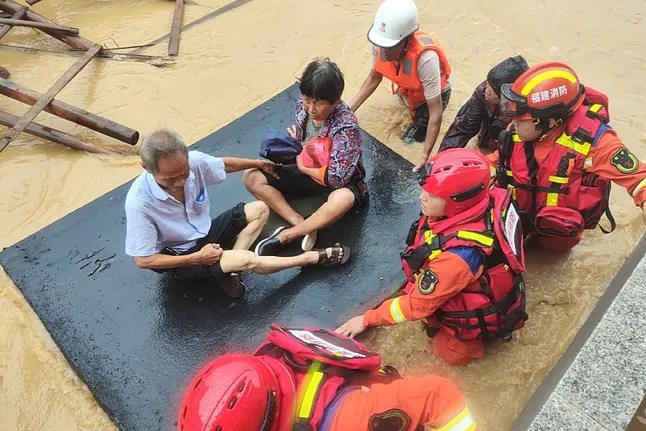The nursing home was flooded in the early hours. The torrential rains had not let up for six days, and that night they reached their peak. At the most critical moment, there were 61 elderly people sleeping in the center, the vast majority with some form of disability. The firefighting and rescue teams arrived after dawn, around 7:00 a.m. But the powerful stream of water coming out of the residence prevented them from accessing the interior. It was not until three hours later that they began to gradually rescue some elderly people and caregivers who were trapped. The rescue operation lasted for more than 24 hours. There were 31 deaths.
The tragedy occurred on Tuesday and Wednesday in the Miyun district, in the northeastern suburbs of Beijing, a mountainous area located about 90 minutes by car from the center of the Chinese capital. It was not until Thursday when authorities reported that among the 44 people who have died in recent days due to the heavy rains in Beijing, 31 of the victims drowned inside the Taishitun Nursing Home, which is very close to the Miyun reservoir, the largest in the region, where the Chaohe and Baihe rivers converge.
The flooded nursing home opened a decade ago to primarily care for sick elderly people with mobility issues, Alzheimer's, or dementia. It also catered to elderly people with low incomes, homeless individuals, or those receiving minimal pensions that do not cover their basic expenses.
"The contingency plan failed because we believed that this nursing home was a safe place and did not include it among the evacuation sites. But it has been shown that our understanding of extreme weather conditions has been inadequate," said the Secretary of the Communist Party of Miyun, Yu Weiguo, acknowledging the mistakes made in disaster prevention policies during a press conference on Thursday.
"After deep reflection on this incident, we recognize that there are still many areas of our work that need improvement. These elderly people were approximately the same age as my parents," he concluded.
The nursing home is located in a low-lying area near a river that had overflowed after unusually intense rains. When the flooding began, around 40 people were trapped inside the main building as water levels rose to almost two meters.
Throughout the week, many residents of the villages in Miyun were evacuated to safe shelters such as schools, military compounds, and hospitals. This district is popular because it is home to a very touristy section of the Great Wall of China and hosts one of the famous water towns, settlements full of hotels and commercial streets surrounded by canals reminiscent of Venice.
In history books, Miyun is also famous in China for being the place where a warlord named Feng stationed his troops while preparing a coup in Beijing in 1924. During the Japanese occupation in the 1930s, a Taoist priest led a peasant revolution against the invaders that ended in a bloody massacre remembered by local families.
Record rains, which have battered Beijing and its neighboring provinces during July, intensified last weekend, devastating densely populated areas on the outskirts of the city. Over 100,000 residents were evacuated. Authorities reported that in just a few days, Miyun recorded rainfall of up to 573.5 millimeters. In comparison, the average annual precipitation in Beijing is around 600 millimeters. Last Monday, the huge reservoir recorded record levels, and the flow of the Qingshui River reached a peak of 2,800 cubic meters per second, 1,500 times its usual flow.
Beijing's Vice Mayor, Xia Linmao, explained that more than 300,000 people were affected by the rain and floods in the capital, with over 24,000 houses, 242 bridges, and 756 kilometers of roads damaged. While around thirty people are still missing in Beijing, in the neighboring Hebei province, a total of 16 deaths have been reported this week due to the storm. Another 10 people died on Wednesday in the northern province of Shanxi when a bus carrying agricultural workers was swept away by heavy rains.
